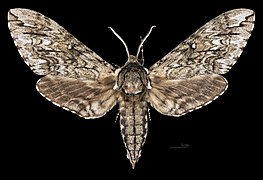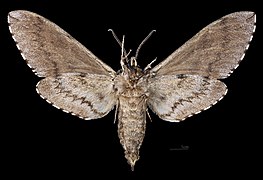
Ceratomia catalpae, the catalpa sphinx, is a hawk moth of the family Sphingidae. The species was first described by Jean Baptiste Boisduval in 1875. Other common names are the Catawba worm, or Catalpa sphinx.

Manduca rustica, the rustic sphinx, is a moth of the family Sphingidae. The species was first described by Johan Christian Fabricius in 1775.
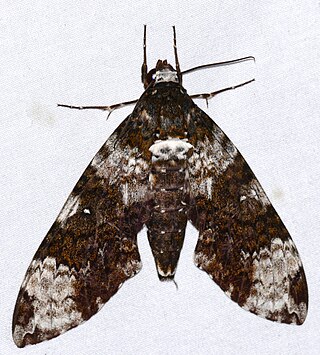
Manduca albiplaga, the white-plaqued sphinx, is a moth of the family Sphingidae. It was first described by Francis Walker in 1856.

Ceratomia is a genus of hawkmoths. The genus was erected by Thaddeus William Harris in 1839. Species include:

Ceratomia amyntor, the elm sphinx or four-horned sphinx, is a North American moth in the family Sphingidae. The species was first described by Carl Geyer in 1835. It has a wingspan of 3+1⁄4-4+1⁄2 inches. As the name suggests, the larvae (caterpillars) feed on elm trees (Ulmus), but they can also be found feeding on birch (Betula), basswood (Tilia), and cherry (Prunus). When the caterpillars are ready, they crawl to the bottom of the host tree, where they crawl underneath the soil and pupate and may overwinter underground if late enough into the year. Vegetable growers should be aware of this larvae due to its insatiable appetite. One of these larvae are capable in devouring huge amounts of plant's foliage and even succulent stems.

Ceratomia hageni, the Osage orange sphinx or Hagen's sphinx, is a hawk moth in the family Sphingidae. The species was first described by Augustus Radcliffe Grote in 1874.

Lintneria eremitus, the hermit sphinx, is a moth of the family Sphingidae. The species was first described by Jacob Hübner in 1823. It is found in the temperate areas of the eastern United States, north into southern Canada over the Great Plains. It prefers gardens and yards, but is common wherever the nectar and larval host plants are found. This moth is easily confused with the Canadian sphinx but these two moths do not typically co-occur.

Paonias excaecata, the blinded sphinx, is a moth of the family Sphingidae. The species was first described by James Edward Smith in 1797.
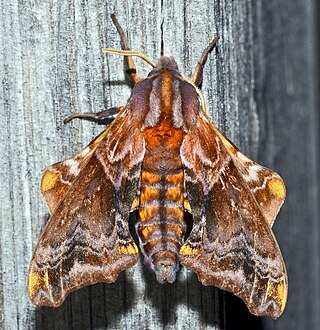
Paonias myops, the small-eyed sphinx, is a moth of the family Sphingidae. The species was first described by James Edward Smith in 1797.
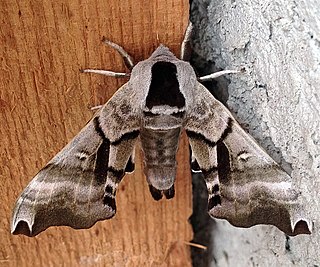
Smerinthus cerisyi, the one-eyed sphinx or Cerisy's sphinx, is a moth of the family Sphingidae. The species was first described by William Kirby who named the species in honor of Alexandre Louis Lefèbvre de Cérisy in 1837.

Smerinthus jamaicensis, the twin-spotted sphinx, is a moth of the family Sphingidae. The species was first described by Dru Drury in 1773.

Amorpha juglandis, the walnut sphinx, is the only species in the monotypic moth genus Amorpha, which is in the family Sphingidae, erected by Jacob Hübner in 1809. The species was first described by James Edward Smith in 1797.
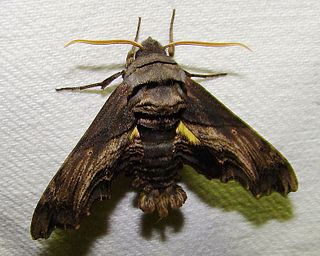
Sphecodina abbottii, or Abbott's sphinx, is a moth of the family Sphingidae. The species was first described by William John Swainson in 1821.
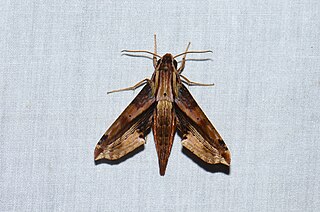
Eupanacra mydon, the common rippled hawkmoth, is a moth of the family Sphingidae.
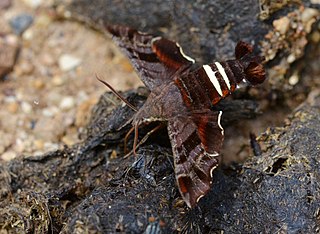
Amphion floridensis, the Nessus sphinx, is a day-flying moth of the family Sphingidae. The species was described by Pieter Cramer in 1777, and renamed in 1920. It is the only member of the genus Amphion erected by Jacob Hübner in 1819. It lives throughout the eastern United States and Canada and occasionally south into Mexico, and is one of the more commonly encountered day-flying moths in the region, easily recognized by the two bright-yellow bands across the abdomen.

Proserpinus lucidus, the Pacific green sphinx or bear sphinx, is a moth of the family Sphingidae first described by Jean Baptiste Boisduval in 1852.
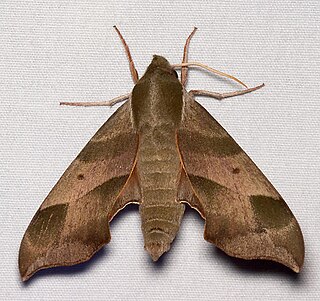
Darapsa myron, the Virginia creeper sphinx, is a moth of the family Sphingidae found in central and eastern North America.

Sphinx gordius, the apple sphinx, is a moth of the family Sphingidae. The species was first described by Pieter Cramer in 1780.
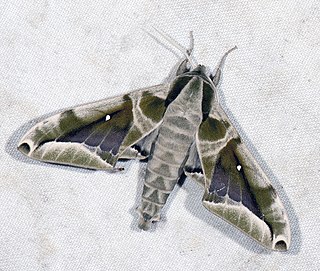
Parum is a genus of moths in the family Sphingidae erected by Walter Rothschild and Karl Jordan in 1903. It is monotypic, witth a single species, Parum colligata, that was first described by Francis Walker in 1856.

Dolbina inexacta, the common grizzled hawkmoth, is a species of moth of the family Sphingidae.

